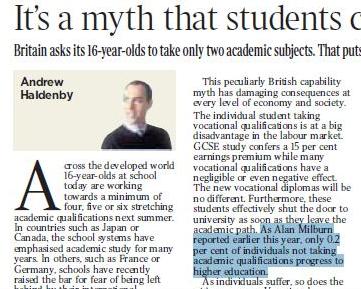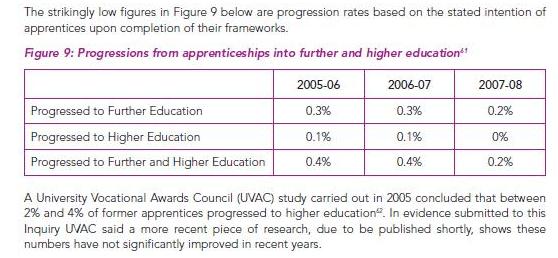Chinese Whispers do apprenticeships no favours
How many students taking non-academic routes finish up in higher education? Writing in The Times on Monday, Andrew Haldenby of Reform reported that “only 0.2 per cent of individuals not taking academic qualifications progress to higher education”.
Strong point, but it’s wrong. What is more, it is possible to trace the long chain of Chinese Whispers by which this false statistic became lodged in the public mind. My thanks to a Straight Statistics reader who put me on the track.
Here's what Andrew Haldenby reported, with the claim highlighted:

His figure came from a report Core Business, published by his think-tank. The basic argument of the report is that in the UK, too few students are stretched academically, too many pushed into vocational qualifications that do not offer a route into higher education. Other countries do not do this, Reform says.
In the report, the particular claim (p 24) about 0.2 per cent is credited to Alan Milburn’s report on access to the professions, Unleashing Aspiration, published earlier this year. Sure enough, the claim does appear in this report, on p 14.

Milburn’s report cites the origin of the figure to an earlier report, the Skills Council's Inquiry into Apprenticeships, published in March this year. It appears as Figure 9 in this report (below).

But what this table is saying is something very different. The strikingly low rates are not figures of the numbers actually progressing, but the “stated intentions” of apprentices about what they will do upon completion of their framework. Apprenticeships are just one of a number of non-academic subgroups – not the whole lot – and these are merely aspirations (admittedly very low) about what they will do later.
In fact, as the note below the table makes clear, there is some evidence that the number going into higher education is between ten and 20 times higher. A study by the University Vocational Awards Council in 2005 concluded that between 2 and 4 per cent of former apprentices progress to higher education. The report did not address non-vocational courses that are not apprenticeships.
It’s still a low number, and nothing to celebrate. But it isn’t 0.2 per cent. Somebody – and the finger must point at the Milburn report, where the misinterpretation first appeared – simply read the Skills Council table wrongly. That’s hardly surprising, as the heading is confusing.
Wrong figures, once they’ve been repeated a few times, tend to become gospel. So we can expect the 0.2 per cent claim to appear again and again. A lie is half-way round the world before truth has got his boots on, as a former Prime Minister once remarked.



